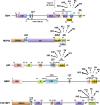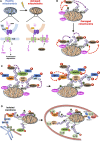Role of Optineurin in the Mitochondrial Dysfunction: Potential Implications in Neurodegenerative Diseases and Cancer
- PMID: 29971063
- PMCID: PMC6018216
- DOI: 10.3389/fimmu.2018.01243
Role of Optineurin in the Mitochondrial Dysfunction: Potential Implications in Neurodegenerative Diseases and Cancer
Abstract
Optineurin (Optn) is a 577 aa protein encoded by the Optn gene. Mutations of Optn are associated with normal tension glaucoma and amyotrophic lateral sclerosis, and its gene has also been linked to the development of Paget's disease of bone and Crohn's disease. Optn is involved in diverse cellular functions, including NF-κB regulation, membrane trafficking, exocytosis, vesicle transport, reorganization of actin and microtubules, cell cycle control, and autophagy. Besides its role in xenophagy and autophagy of aggregates, Optn has been identified as a primary autophagy receptor, among the five adaptors that translocate to mitochondria during mitophagy. Mitophagy is a selective macroautophagy process during which irreparable mitochondria are degraded, preventing accumulation of defective mitochondria and limiting the release of reactive oxygen species and proapoptotic factors. Mitochondrial quality control via mitophagy is central to the health of cells. One of the important surveillance pathways of mitochondrial health is the recently defined signal transduction pathway involving the mitochondrial PTEN-induced putative kinase 1 (PINK1) protein and the cytosolic RING-between-RING ubiquitin ligase Parkin. Both of these proteins, when mutated, have been identified in certain forms of Parkinson's disease. By targeting ubiquitinated mitochondria to autophagosomes through its association with autophagy related proteins, Optn is responsible for a critical step in mitophagy. This review reports recent discoveries on the role of Optn in mitophagy and provides insight into its link with neurodegenerative diseases. We will also discuss the involvement of Optn in other pathologies in which mitophagy dysfunctions are involved including cancer.
Keywords: autophagy; autophagy receptor; cancer; mitophagy; neurodegenerative diseases; pathologies.
Figures




Similar articles
-
Temporal dynamics of PARK2/parkin and OPTN/optineurin recruitment during the mitophagy of damaged mitochondria.Autophagy. 2015;11(2):422-4. doi: 10.1080/15548627.2015.1009792. Autophagy. 2015. PMID: 25801386 Free PMC article.
-
Optineurin is an autophagy receptor for damaged mitochondria in parkin-mediated mitophagy that is disrupted by an ALS-linked mutation.Proc Natl Acad Sci U S A. 2014 Oct 21;111(42):E4439-48. doi: 10.1073/pnas.1405752111. Epub 2014 Oct 7. Proc Natl Acad Sci U S A. 2014. PMID: 25294927 Free PMC article.
-
Dynamic recruitment and activation of ALS-associated TBK1 with its target optineurin are required for efficient mitophagy.Proc Natl Acad Sci U S A. 2016 Jun 14;113(24):E3349-58. doi: 10.1073/pnas.1523810113. Epub 2016 May 31. Proc Natl Acad Sci U S A. 2016. PMID: 27247382 Free PMC article.
-
Optineurin: A Coordinator of Membrane-Associated Cargo Trafficking and Autophagy.Front Immunol. 2018 May 15;9:1024. doi: 10.3389/fimmu.2018.01024. eCollection 2018. Front Immunol. 2018. PMID: 29867991 Free PMC article. Review.
-
Altered Functions and Interactions of Glaucoma-Associated Mutants of Optineurin.Front Immunol. 2018 Jun 6;9:1287. doi: 10.3389/fimmu.2018.01287. eCollection 2018. Front Immunol. 2018. PMID: 29951055 Free PMC article. Review.
Cited by
-
Accuracy of a machine learning method based on structural and locational information from AlphaFold2 for predicting the pathogenicity of TARDBP and FUS gene variants in ALS.BMC Bioinformatics. 2023 May 19;24(1):206. doi: 10.1186/s12859-023-05338-5. BMC Bioinformatics. 2023. PMID: 37208601 Free PMC article.
-
Genetic impacts on nigral iron deposition in Parkinson's disease: A preliminary quantitative susceptibility mapping study.CNS Neurosci Ther. 2023 Jul;29(7):1776-1784. doi: 10.1111/cns.14135. Epub 2023 Feb 27. CNS Neurosci Ther. 2023. PMID: 36852447 Free PMC article.
-
Role of Mitophagy in Regulating Intestinal Oxidative Damage.Antioxidants (Basel). 2023 Feb 14;12(2):480. doi: 10.3390/antiox12020480. Antioxidants (Basel). 2023. PMID: 36830038 Free PMC article. Review.
-
Impaired Mitophagy in Neurons and Glial Cells during Aging and Age-Related Disorders.Int J Mol Sci. 2021 Sep 23;22(19):10251. doi: 10.3390/ijms221910251. Int J Mol Sci. 2021. PMID: 34638589 Free PMC article. Review.
-
Mitofusin1 Is a Major Mediator in Glucose-Induced Epithelial-to-Mesenchymal Transition in Lung Adenocarcinoma Cells.Onco Targets Ther. 2020 Apr 24;13:3511-3523. doi: 10.2147/OTT.S238714. eCollection 2020. Onco Targets Ther. 2020. PMID: 32425551 Free PMC article.
References
Publication types
MeSH terms
Substances
LinkOut - more resources
Full Text Sources
Other Literature Sources
Medical
Research Materials

